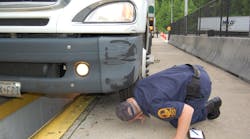One of the most common violations that Will Schaefer sees during the Commercial Vehicle Safety Alliance’s (CVSA) annual Brake Safety Week is out-of-adjustment brakes.
Schaefer, who is CVSA’s director of vehicle programs, noted that 20% of commercial vehicles on the road are placed out of service for violations – half of which are brake-related. And more than half of those are due to out-of-adjustment problems.
Schaefer suggested carriers conduct pre-trip inspections to ensure brakes are properly adjusted. If during the pre-trip they find brakes are out-of-adjustment, they should have a technician diagnose and properly fix the problem, rather than manually adjusting the brakes themselves.
Keith McComsey, director of marketing & customer solutions for Bendix’s Wheel-End Division, also noted the value of pre-trip inspections as an opportunity for carriers and fleet technicians to identify and fix problems before a vehicle is put out of service.
“Identifying and correcting the overall problem is key in keeping the vehicle safe and in compliance,” McComsey told Fleet Owner. “Just adjusting the brakes will cause them to fall out of adjustment over time and might lead to a failed inspection.”
During the week of Sept. 11-17, 2016, law enforcement agencies across North America will conduct inspections on large trucks and buses to identify out-of-adjustment brakes, and brake-system and anti-lock braking system (ABS) violations as part of CVSA’s annual outreach and enforcement campaign.
CVSA noted that brake-related violations comprised the largest percentage (representing 43%) of all out-of-service violations cited during Operation Airbrake’s companion International Roadcheck campaign in 2015, which focused on inspections of both vehicles and drivers.
Inspections conducted during Brake Safety Week include:
- Brake-system components to identify loose or missing parts
- Air or hydraulic fluid leaks
- Worn linings, pads, drums or rotors
- Other faulty brake-system components
ABS malfunction indicator lamps are also checked. “It’s not an out-of-service condition,” Schaefer explained. “But if a lamp is illuminated, it is a violation. If when they do the inspection, the lamp never comes on, that’s also a violation. If the lamp doesn’t light up at all when you turn the key or apply power to the system, that is a violation. We are interested in knowing how prevalent these violations are because ABS is an important tool in helping the driver maintain control in slippery conditions.”
McComsey also suggests drivers:
- Test for leaks. Check air lines coming down from the chassis to the wheel-end, where there are always opportunities for leaks. Provide feedback to the technician to make the proper repairs.
- Listen for leaks in connection points
- Examine brake shoes to meet the minimum lining thickness standards
- Check for cracks and tears in the brake system
- Measure chamber strokes to ensure they’re in accordance with industry standards
- Pay attention to rubber boots
He added that corrosion has always been a big problem and could contribute to out-of-spec components and a vehicle being placed out of service.
So, what’s different this year? In the past, CVSA had looked at automatic slack adjusters and manual slack adjusters – counting to figure out how many there are and which ones are out of adjustment, Schaefer said. But that will change this year.
“About 90% of vehicles on the road are required to have automatic slack adjuster,” Schaefer explained. “There is a misconception that they don’t work because they go out of adjustment. If you have an automatic slack adjuster and the brake is out of adjustment, you need to diagnose the whole brake system. Something else could be completely failed. That’s what we find significantly in the inspections.”
“We know that automatic slack adjusters are half as likely to be out of adjustment as manual slack adjusters,” he added. “They are effective. We stopped counting those this year.”
When it comes down to it, though a pre-trip inspection document isn’t required during the inspection campaign, both Schaefer and McComsey stressed the importance of conducting pre-trips and reporting problems early.
“I think the most important, basic thing a driver can do is a pre-trip inspection and report [problems] to your carrier,” Schaefer said. “You can tell the officer that you know that you have those repairs to do. Document and fix those problems when you know you have your next dispatch or chance to fix it.”




